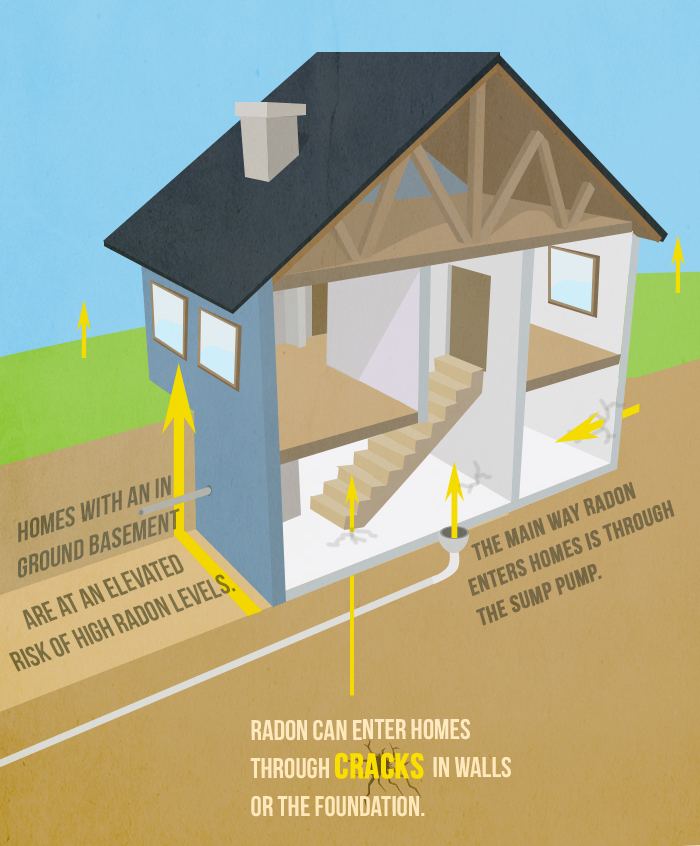Radon gas is responsible for 21,000 lung cancer deaths per year, or 58 deaths per day. It carries approximately 1,000x the risk of death as any other EPA carcinogen.
The Environmental Protection Agency (EPA) estimates that nearly one out of every 15 homes in the United States has an unsafe level of radon gas.
All homeowners and potential home buyers should regularly test for radon.
What is radon gas?
Radon gas is a naturally occurring, radioactive, odorless, colorless, tasteless gas. It dramatically increases the risk of cancer in those who inhale air contaminated with it for long periods of time. Radon is produced by the radioactive decay of uranium deposits in rocks, soil, and water. It is present in all 50 U.S. states.
The EPA reports that radon presence can vary by day, season and geographic area. It can even vary in a small area such as between you and your next door neighbor’s home. The level of radon ultimately depends on the local geology, how houses were built and the materials that were used to construct them.
Since you cannot see or smell radon gas, testing is the only way to determine if the air and water in your home contains it.
Radon gas poses a serious health risk
According to the Environmental Protection Agency (EPA), when you breathe radon-contaminated air, you increase your risk of developing lung cancer. In fact, the U.S. Surgeon General warns that radon is the second-leading cause of lung cancer in this country next to smoking. Smoking also enormously increases the risk of lung cancer from radon exposure.
Due to lung shape and smaller size, children have higher estimated radiation rates from radon. The risk of lung cancer for children exposed to radon is 20x that of children exposed to cigarette smoke.
How does it get in my Home?
Since the air pressure inside of your home is generally lower than the pressure in the soil around the foundation, your house acts as a vacuum, drawing radon gas in through porous construction materials, cracks, and openings, into basements, crawlspaces and walls. If the structure does not have adequate ventilation, the gas builds to unhealthy levels causing damage to the lungs of those who breathe it in.
Radon may also be present in your water source and can consequently be ingested when drinking or released into the air when water is used for general household purposes, like showering.
Easy-to-use, mobile monitors for home and office measure radon levels anywhere, anytime, providing consistent, continuous information about changing radon levels in your home or workplace.

Testing
You can personally test your home using a device available at your local store, purchase it online, or hire a qualified contractor to test for you.
Test Results
If a radon test reveals that the home level is 4 pCi/L or above, then the level of radon in the air is a danger to your health. A home that tests above .4 pCi/L is exposed to 35x as much radiation as the Nuclear Regulatory Commission would allow on a radioactive waste site!
To put this in perspective, the normal outdoor level is roughly 0.4 pCi/L. Although this level is not always an attainable goal due to technological constraints, radon levels can be reduced by installing a radon mitigation system.
A qualified radon reduction contractor can install a radon mitigation system in your home for approximately $800 to $2,500. If your home’s water source has high levels of radon, the contractor can install a point-of-entry treatment device. Mitigating radon in your home can save the lives of the people you love most.
Sources:
Tennessee Radon Services: Radon Dangers
Airthings.com, Radon: What is it and why is it dangerous?
How Stuff Works, How Radon Works
Infographic Source: UnityPoint Health, Des Moines
Please note that the information contained in this posting is designed to provide authoritative and accurate information, in regard to the subject matter covered. However, it is not provided as legal or tax advice and no representation is made as to the sufficiency for your specific company’s needs. This post should be reviewed by your legal counsel or tax consultant before use.

